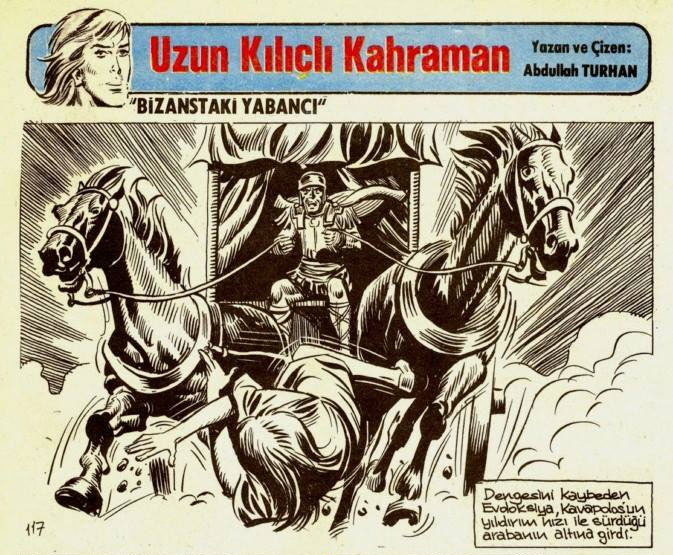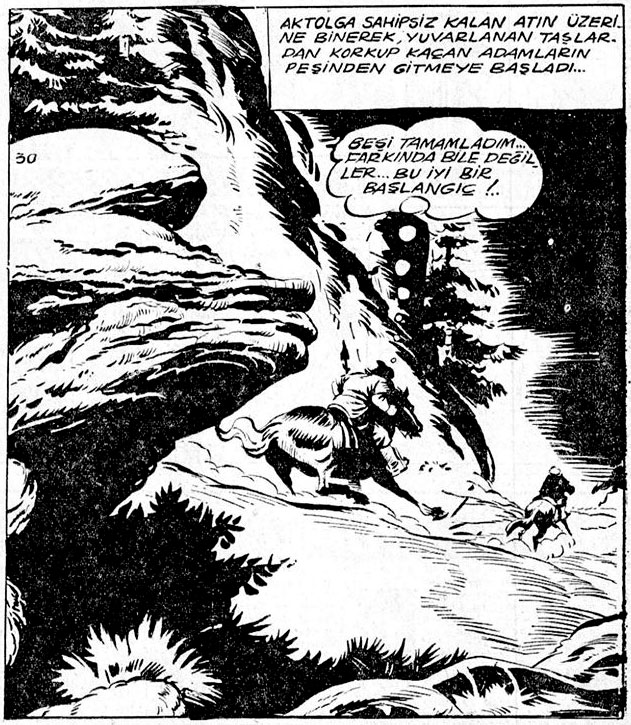Abdullah Turhan was an illustrator, painter, and one of the leading artists of Turkish adventure comics. His career spanned from the 1950s through the 2000s, during which he drew historical swordswingers like 'Uzun Kılıçlı Kahraman' (1962-1971), 'Kara Murat' (1971-1998), 'Tolga' (1971-1983) and 'Burak Bey' (1972, 1987-2000). Their heroics took place during the heydays of the Ottoman Empire, all rendered in Turhan's aesthetic and detailed drawing style.
Early life
Abdullah Turhan was born in 1933 in Akçaabat, a town along the coast of the Black Sea in the Trabzon Province. His official birth date was 1 January 1933, but at the time remote villagers of Anatolia often didn't declare the birth of a child at the town hall until several months later. As a result, the parents often no longer knew the exact date of birth, and the municipal employee therefore declared that the child was born on 1 January. He had an early interest in comics and drawing, copying famous heroes like Hal Foster's 'Tarzan', Lee Falk & Phil Davis' 'Mandrake the Magician' and Lee Falk and Ray Moore's 'The Phantom' in his notebooks. His high school drawing teacher was impressed by his talent, but this was as far as his formal education went. A fully self-taught artist, Turhan headed for Istanbul in 1950 to try to get his work published. In January 1954, he won a contest held by the newspaper Yeni Sabah, and subsequently finetuned his craft under the guidance of one of the paper's comic artists, Ratip Tahir Burak. Among his other artistic influences were the Turkish artist Sururi Gümen and the American cartoonist Alex Raymond.
Early newspaper and magazine comics
From the 1950s on, Turhan published his comics and illustrations in several leading Turkish newspapers, including Yeni Sabah, Akşam, Son Havadis, Milliyet, Hürriyet, Günaydın and Sabah. But magazines also requested his services. By 1956, he was present in the children's magazine Şen Çocuk with a feature about the 17th-century Sultan Gazi Hüseyin Pasha ('Deli Hüseyin Paşa') and a humor comic about the legendary 13th-century folkloric trickster character Nasreddin Hodja ('Nasreddin Hoca'), which he both signed with Abduş.
Under the pen name Turan, he contributed illustrations and comic strips to Pazar, Yeni Sabah's Sunday supplement magazine, from 1957 on. He adapted several foreign novels into comic strip format, including Louis-Charles Royer's 'L'Amour à Honolulu' ('Honolulu'da Aşk', 1960) and Maurice Limat's 'Le Messager du Diable' '(Şeytanın Elçisi'). He also launched his comic soap opera 'Aşk ve Vazife' (literally: "Love and Duty", 1959), followed by similar serials such as 'Tehlikeli Oyun' ("Dangerous Game"), 'Acı Zafer' ("Bitter Victory"), 'Yarın Olmadı' ("No Tomorrow"), 'Şeytanın Elçisi' ("The Devil's Ambassador"), 'Seni Terketmeyeceğim' ("I Will Not Leave You"), 'Honolulu'da Aşk' ("Love in Honolulu") and 'Arzu Toprağu' ("The Land of Desire"). Turhan's final comic for Yeni Sabah/Pazar was the detective serial 'Cani Peşinde' ("In Pursuit of a Criminal"). His collaboration with the paper ended when it went out of print in 1964.
'Uzun Kılıçlı Kahraman'.
Tolga and other heroes: origins
During the 1960s, both Abdullah Turhan and his colleague Suat Yalaz became the main representatives of a new tradition in Turkish comics: stories about heroic figures in national history. The foundations for this new genre were laid back in 1925, when writer, architect and entrepreneur Abdullah Ziya Kozanoğlu serialized his breakthrough novel 'Kızıltuğ' in the magazine Resimli Mecmua. It was the first historical adventure novel in the Turkish republic, telling the Turkish history of Central Asia in the 13th century. The book has acted as an inspiration for comics, literature and films to this day. In the late 1950s, Kozanoğlu himself began writing comics serials set in this same time period. At first with Ratip Tahir Burak and then with Suat Yalaz, with whom he adapted his book into the comic 'Kaan Cengiz Han'ın Hazineleri' ("Kaan and the Treasures of Genghis Khan") for the newspaper Akşam. Kozanoğlu and Yalaz worked on nine further 'Kaan' stories (1959-1961), until the writer left and Yalaz transformed the series into his own signature series, 'Karaoğlan' (1962). Abdullah Turhan had been serving as Yalaz' assistant on both 'Kaan' and 'Karaoğlan', and was asked to take over when Suat Yalaz left the paper later that year. The feature returned to its original name, 'Kaan', and Turhan created four episodes ('Kerayit Güzeli', 'Tung Hayin Öcü', 'Disi Panter' and 'Bizan'taki Yabanci'). The artist then restyled the series once again and continued it in Akşam under the title 'Uzun Kılıçlı Kahraman' ("The Hero With The Long Sword"), while Yalaz started publishing 'Karaoğlan' in a separate series of comic books. So basically, two different comic series were born from the same source.
Cover illustrations for Tolga.
Tolga
By the late 1960s, 'Uzun Kılıçlı Kahraman' was restyled and reshaped into the adventures of 'Tolga'. Around 1968, Turhan was working for the magazine Yeni 1001 Roman, for which he initially made the historical serial 'Orta Asyalı Kahraman' ("Central Asian Hero"), before introducing 'Tolga' in November 1968. The blonde Tolga in his trademark animal coat was an archetypical hero with an unshakable will and merciless strength, who fights the enemies of the Turkish people in Central Asia with his sword and bow. With its graphic violence and portrayals of severed limbs, 'Tolga' was aimed at an adult readership. Throughout the 1970s and first half of the 1980s, Abdullah Turhan published the heroics of 'Tolga' in several series of comic books. Editor Nezih Demirkent of the newspaper Hürriyet was kind enough to support Turhan's publishing endeavors with free weekly advertisements. After a first series was launched on 14 June 1971, 77 issues of a weekly pocket book were published between 21 January 1973 and 18 July 1974. A monthly magazine was launched in March 1979, followed by a new digest-sized series published by Şilliler Yayınevi between 19 April 1983 and 19 June 1984. Finally, in 1998, the adventures of 'Tolga' appeared in the daily Günaydın.
'Aktolga'.
Other historical comics
'Uzun Kılıçlı Kahraman' and 'Tolga' were by far not Turhan's only Ottoman heroes. He wrote and illustrated historical serials about the hero 'Kara Sinan' for the newspaper Son Havadis and paper Yeni İstanbul, the author made three stories of 'Aktolga' (1964-1965) and one epic saga with 'Karabatur' (1970). With the scriptwriter Ahmet Ziya Kozanoğlu, the son of Abdullah Ziya Kozanoğlu, he worked on twelve comic books about 'Alptekin' (1968-1969), published at first by Bilge Şakrak Yayınları and then by Nil Yayınevi. The adventures of the mustached fencer were set in the days of Sultan Suleiman the Magnificent, during the 1529 Siege of Vienna. The comic books also contained (traced?) episodes of the American 'Turok' comic, and very crudely redrawn versions of the Franco-Belgian classics 'Gaston Lagaffe' (by André Franquin), 'Poussy' (Peyo) and 'Boule et Bill' (Jean Roba) by a yet to be identified local doodler.
Abdullah Turhan's 'Burak Bey' (1972) told the adventures of an Ottoman army scout and were created in cooperation with writer Nizamettin Veziroğlu (who worked under the pen name Selahattin Duman). The series was revived between November 1987 and August 2000 in the newspaper Sabah. 'Deryalar Delisi Umur Bey' ("Umur Bey, the Fool of the Sea") was yet another spiky hero, who initially appeared in the newspaper Yeni Asır under the name 'Ege', but who became the back-up feature in the 'Tolga' books from the 284th edition on.
Kara Murat
Abdullah's biggest claim to fame was launched in 1971. 'Kara Murat' ("Black Murat") was created by the writer and journalist Rahmi Turan Muratoğlu by commission of newspaper mogul Haldun Simavi. The series began publication in Simavi's newspaper Günaydın, of which Muratoğlu was the publishing director. Nicknamed "The Conqueror's Sentry", the hero was a 15th-century raider in the Ottoman army during Sultan Mehmed the Conqueror. Turhan based Kara Murat's looks on the popular Kurdish actor Yılmaz Güney (1937-1984). Kara Murat grew out into one of Turkey's most beloved comic characters, and his adventures were published in the comic book Fatih'in Fedaisi Kara Murat, which appeared every Wednesday from 3 January 1974 on. Abdullah Turhan drew 20 long adventures with his hero until 1986. Later episodes were drawn by Ertan Tank and Süleyman Gök, while Ragıp Derin was drawing adventures of Kara Murat's regular sidekick 'Durakoğlu'. Yücel Köksal provided many cover illustrations. By 1988, the rights were bought by publisher Bilka Yayınevi, who continued the title until 11 March 1992. After 946 issues, the adventures of 'Kara Murat' continued in 15 issues of the comic book dedicated to Sezgin Burak's 'Tarkan' (1992). In 1995, the newspaper Sabah reprinted some of Abdullah Turhan's older stories under the title 'Durakoğlu'.
The Turkish film producer Türker İnanoğlu and director Natuk Baytan adapted Kara Murat's adventures into five live-action feature films, with Cüneyt Arkıin in the title role: 'Kara Murat: Fatih'in Fedaisi' (1972), 'Kara Murat: Fatih'in Fermani' (1973), 'Kara Murat: Ölüm Emri' (1974), 'Kara Murat: Kara Sövalyeye Karsi' (1975) and 'Kara Murat: Seyh Gaffar'a Karsi' (1976).
Further comics work
While Abdullah Turhan is mostly remembered for his historical comics, he has also worked on some contemporary features. In 1973 ,he created the funny comic book '49 Şaban Tagor'a Karşi', in which he spoofed other comic strips and TV series, such as EsseGesse's 'Captain Miki', Sergio Bonelli and Gallieno Ferri's 'Zagor', Morris' 'Lucky Luke' and 'Star Trek'. Some of Turhan's later comic strips were soccer-related. 'Gol Kralı' ("The King of Goals") in 1001 Roman, for instance, was based on the legendary Turkish player Metin Oktay (1936-1991). By 1991 the series also appeared in the sports magazine Fotomaç. Turhan's other soccer comic was 'Ağlara Takılan Umut' ("Hope Caught In The Nets", 1984) and ran in Günaydın Arkadaş.
By 1985, Turhan was present in the newspaper Sabah with a new comic strip about the soldier 'Hilmo', but quit after six episodes because of creative differences, leaving the strip to Ragıp Derin. He was, however, back in the paper for new 'Burakbey' stories (1987-2000) in cooperation with the scriptwriter Selahattin Duman. Abdullah Turhan also served as a cover artist for the children's magazine Çocuk Haftası, as well as 'Kansas Kid' and 'Deyvi Kroket' comic books published by Karaoğlan.
Assistance
As Abdullah Turhan produced several comic series at the same time, he opened a drawing studio on Babıali Avenue, the former newspaper district, nowadays called Cağaloğlu Avenue. For the art duties (coloring, illustrations of cover pages, etc.), he got assistance from three fellow artists: Hikmet Yamansavaşçılar, Süleyman Turan (caricaturist, draftsman and theater/cinema actor) and Cemal Dündar (an illustrator for book covers, film posters and daily newspapers).
Final years
Even though the was largely retired during the 2000s, Abdullah Turhan continued to draw in old age. He spent his final years in Datca, where he made oil paintings. In 2015, he illustrated 'Acemi Kâşifler Hattuşa'nın Güneşi' ("Novice Explorers, the Sun of Hattusha"), a children's comic written by Meltem Erinçmen Kânoğlu. The grandmaster of Turkish adventure comics passed away on 2 March 2020 at the age of 87. Coincidentally, he died on exactly the same day as his colleague Suat Yalaz, who was one year older.













